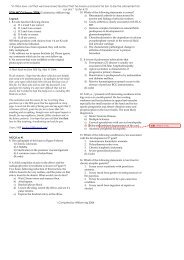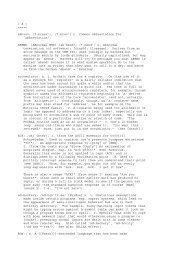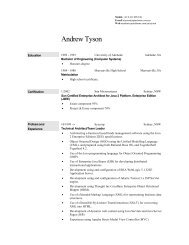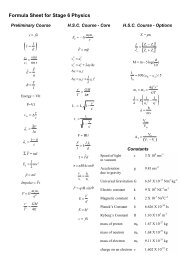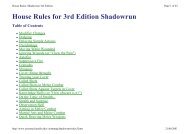Notes to Submission to the Productivity Commission Inquiry into the ...
Notes to Submission to the Productivity Commission Inquiry into the ...
Notes to Submission to the Productivity Commission Inquiry into the ...
You also want an ePaper? Increase the reach of your titles
YUMPU automatically turns print PDFs into web optimized ePapers that Google loves.
etween activity restriction and disability has not been fully spelled out in <strong>the</strong> disabilityliterature, but in economic terms, <strong>the</strong> difference between <strong>the</strong>m is one of cost incidence. Interms of outcome, both lead <strong>to</strong> less social participation and activity-restriction than wouldoccur if more resources were spent on technologies and design, but in terms of costincidence, it is useful <strong>to</strong> distinguish between participation-enhancing expendituresundertaken by <strong>the</strong> person with <strong>the</strong> impairment and participation-enhancing expendituresby o<strong>the</strong>r individuals and institutions. Thus, expenditure constraints on <strong>the</strong> part ofindividuals with impairment leads <strong>to</strong> activity-restriction and expenditure constraints on<strong>the</strong> part of o<strong>the</strong>rs leads <strong>to</strong> disability and conversely. In terms of <strong>the</strong> products <strong>the</strong>mselves,it may be useful <strong>to</strong> see activity-restrictions as being overcome by assistive devices, anddisability as being overcome by public design features.Thus for example, an individual with impairment can overcome what would o<strong>the</strong>rwise bean activity-restriction by <strong>the</strong> purchase of a wheelchair, a hearing aid, eyeglasses, acomputer or pharmaceutical drugs. In each of <strong>the</strong>se cases, social participation can beenhanced by expenditure by <strong>the</strong> person with <strong>the</strong> impairment, and where it is no<strong>to</strong>vercome because of a lack of resources, <strong>the</strong> person with impairment faces an activityrestriction.It is important <strong>to</strong> note that technological developments are dramatically expanding <strong>the</strong>range of available assistive devices, and in doing so, improve <strong>the</strong> potential participationprospects of people with impairments. But devices may be expensive and beyond <strong>the</strong>budgets of many people with impairment, and that without increased incomes,technological possibilities do not translate in<strong>to</strong> an actual reduction in activity restrictions.Similarly, businesses, government and households can ensure that building andequipment design is enabling ra<strong>the</strong>r than disabling; that information formats enablecommunication ra<strong>the</strong>r than filter it; and that schedules, policies and procedures aresufficiently flexible <strong>to</strong> enable greater participation by people who would o<strong>the</strong>rwise beexcluded from participation.An increase in <strong>the</strong> number of people with impairments due <strong>to</strong> an ageing population andimproved mortality-decreasing medical technology increase <strong>the</strong> community’s awarenessof <strong>the</strong> numbers of people with impairment, and <strong>the</strong>reby also improve <strong>the</strong> prospects ofenabling social infrastructure. But impairment-oriented design involves re-directingresources from o<strong>the</strong>r uses, and <strong>the</strong>re is nothing <strong>to</strong> ensure that such a re-direction is likely<strong>to</strong> be supplied by ei<strong>the</strong>r au<strong>to</strong>nomous individual ac<strong>to</strong>rs in a market setting, or bygovernment.The distinction between impairment, activity-restriction and disability shifts <strong>the</strong> focusfrom a medical outlook which allocates resources <strong>to</strong> minimise impairment by medicaltechnology <strong>to</strong> an economic outlook which allocates resources <strong>to</strong> minimising activityrestrictionand disability by enabling ra<strong>the</strong>r than disabling design in goods, services,procedures and policies.5



